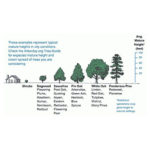How to consider “ultimate size”

Designers need to consider many factors when choosing plant material. Evergreen, herbaceous, deciduous? Foliage or flower color, bloom time, preferred growing conditions and so on. One of the most important considerations is plant habit and "ultimate size".
What does "ultimate size" mean?
- Complete in natural development or growth.
- A tree or plant that has reached a desired size or age for its intended use.
Like the old saying goes “Right plant, right place”. Planning and research is vital when evaluating ultimate size to avoid future problems. In addition to knowing how large a given plant may grow, you also should factor in the growth RATE. Dwarf plants aren't always that small at maturity but if it takes them 50 years to get there is that really going to be an issue? On the other hand, popular plants like Colorado Spruce or Weeping Cherry tend to outgrow their siting in a decade or two.

Research is important, and not just on the habit and size of the plant but also the root system, which is often overlooked. For example, don’t plant a Willow tree over a septic tank. Yes, someone I will call ...John Doe... did this to get back at his landlord. Now that might be an example of someone who knew what “ultimate size” would do with the wrong intentions but, planning is everything.

Is it going next to the house? Sidewalk? Driveway? Near power lines? If it’s a row of pine, are you planting them too close to each other making them susceptible to needle diseases in the future? Will the property owner be able to shimmy past the planting bed to get to the building entrance a few years from now? These are just a few examples of what to consider when choosing the right plant.

Above image courtesy of the Arbor Day Foundation (www.arborday.org)
